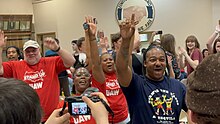United Auto Workers
It was known for gaining high wages and pensions for automotive manufacturing workers, but it was unable to unionize auto plants built by foreign-based car makers in the South after the 1970s, and it went into a steady decline in membership; reasons for this included increased automation, decreased use of labor, mismanagement, movements of manufacturing (including reaction to NAFTA), and increased globalization.[2] For most of its history, the American Federation of Labor (AFL) had only focused on organizing skilled workers practicing specific trades, an approach known as craft unionism.[9] After the Toledo local led an unauthorized but successful strike against General Motors (GM), the AFL caved to pressure and called for a convention.The union found rapid success with the sitdown strike, a tactic where workers "sit down" at their work stations to occupy a factory.[14] Sitdown strikes enabled small numbers of workers to interrupt the assembly line and stop production across an entire plant.By January 25, strikes and the effects of production shutdowns idled 150,000 workers at fifty General Motors plants from California to New York.[citation needed] Walter Reuther won the election for president at the UAW's constitutional convention in 1946 and served until his death in an airplane accident in May 1970.Reuther would pick one of the Big Three automakers (General Motors, Ford, and Chrysler), and if it did not offer concessions, he would strike it and let the other two absorb its sales.The UAW disaffiliated from the AFL–CIO on July 1, 1968, after Reuther and AFL–CIO President George Meany could not come to agreement on a wide range of policy issues or reforms to AFL–CIO governance.[33] On July 24, 1968, just days after the UAW disaffiliation, Teamsters General President Frank Fitzsimmons and Reuther formed the Alliance for Labor Action as a new national trade union center to organize unorganized workers and pursue leftist political and social projects.[25] The UAW became strongly anti-communist after it expelled its Communist leaders in the late 1940s following the Taft–Hartley Act, and supported the Vietnam War and opposed the antiwar Democratic candidates.At the same time, it used this rhetoric to simultaneously rebuff the demands and limit the organizing efforts of Black workers seeking to overcome institutional racial hierarchies in the workplace, housing, and the UAW.UAW workers receiving generous benefit packages when compared with those working at non-union Japanese auto assembly plants in the U.S., had been cited as a primary reason for the cost differential before the 2009 restructuring.[52] The Big Three also based their respective market strategies on fuel-inefficient SUVs, and suffered from lower quality perception (vis-a-vis automobiles manufactured by Japanese or European car makers).In 2010, Bob King hired Richard Bensinger to organize Japanese, Korean, and German transplant factories in the United States.[62] In March 2020, the Detroit United Auto Workers union announced that after discussion with the leaders of General Motors, Ford, and Fiat Chrysler Automobiles, the carmakers would partially shut down factories on a "rotating" basis to combat the COVID-19 pandemic.[64] A corruption probe by the Justice Department against UAW and 3 Fiat Chrysler executives was conducted during 2020 regarding several charges such as racketeering, embezzlement, and tax evasion.[65][66][67] It resulted in convictions of 12 union officials and 3 Fiat Chrysler executives, including two former Union Presidents, UAW paying back over $15 million in improper chargebacks to worker training centers, payment of $1.5 million to the IRS to settle tax issues, commitment to independent oversight for six years, and a referendum that reformed the election mode for leadership.[74] After the success of the strike, in November 2023, the UAW announced that it was launching a simultaneous campaign to unionize 150,000 workers at other automakers with plants in the United States: BMW, Honda, Hyundai, Lucid, Mazda, Mercedes, Nissan, Rivian, Subaru, Tesla, Toyota, Volkswagen, and Volvo.[75][76] In April 2024, after two failed attempts, 73% of workers at the Volkswagen (VW) Chattanooga, Tennessee plant voted to join the UAW,[3][77][78] the union's first victory in the South outside Detroit's Big Three.[79] District 65, a former affiliate of the Retail, Wholesale and Department Store Union that included as a predecessor the United Office and Professional Workers of America, merged into the UAW in 1989.
UAW (disambiguation)Trade unionDetroitMichiganOntarioShawn FainCanadian Auto WorkersAFL–CIOCanadian Labour CongressIndustriALL Global UnionEndowmentAmerican labor unionPuerto Ricosouthern OntarioCongress of Industrial OrganizationsWalter Reutherautomotive manufacturing workersautomationglobalizationGeneral Motors (Flint)ChryslerFord (Canada)International HarvesterJohn DeereFreightlinerVolvo (Virginia)University of CaliforniaHarperCollinsGM, Ford, StellantisAmerican Federation of Laborcraft unionismNational Industrial Recovery ActWilliam Greencovering the entire industryGeneral MotorsJohn L. Lewissitdown strikeassembly lineFlint sit-down strikeNational GuardNational Labor Relations ActFord Motor CompanyHarry BennettBattle of the OverpassRouge plantclosed shopShelton TappesCommunistsWorld War IILillian HatcherUnited Auto Workers strike of 1945–1946Reuther's Treaty of DetroitAmerican MotorsaerospaceGeorge MeanyTeamstersFrank FitzsimmonsAlliance for Labor Actionnational trade union centerdual unionBlack Lake, MichiganWayne State UniversityNew Deal CoalitionGreat SocietyTaft–Hartley ActVietnam WarDearborn, MichiganSojourner TruthLeague of Revolutionary Black WorkersDodge Revolutionary Union MovementEarth DayDenis Hayesoil embargolate-2000s recessionautomotive industry crisis of 2008–10Chapter 11Andrew Ross SorkinDeep South2003-2008 oil crisissport utility vehiclespickup trucksGreat RecessionBob KingRichard BensingerChattanoogaminority unionFiat Chrysler AutomobilesCOVID-19 pandemic2022 University of California academic workers' strikeJustice Departmentracketeeringembezzlementtax evasionA strike against all big three automakersChattanooga, TNthe SouthRetail, Wholesale and Department Store UnionUnited Office and Professional Workers of Americaunion for postdoctoral scholarsUAW Local 5810Homer MartinR. J. ThomasLeonard WoodcockDouglas FraserOwen BieberStephen YokichRon GettelfingerDennis WilliamsGary JonesRory GambleRay CurryGeorge AddesEmil MazeyRay MajerusElizabeth BunnAutoworker CaravanFinal OfferLeon E. BatesList of United Auto Workers local unions2007 Freightliner wildcat strike2007 General Motors strike2019 General Motors strikeCommunists in the United States Labor Movement (1919–1937)Communists in the United States Labor Movement (1937–1950)Women in labor unionsreceivership